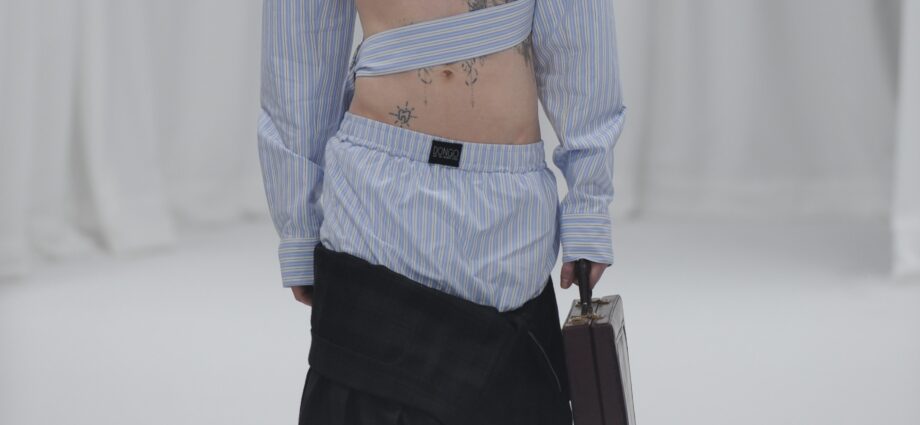Britain’s biggest luxury fashion import-export business by far is education. London College of Fashion (confusingly part of UAL, which also contains Central Saint Martins) is a big magnet for international students in particular. In the 25th anniversary year of the LCF Fashion Design Technology MA, the college put on a multimedia event for its 41 graduates: student films, a showroom, and a men’s and women’s runway show of 13 designers.
Studying in London’s educational system is indeed a luxury if you can afford it, but it’s hard, applied work. Taking on and using one’s own psychology, co-opting authentic homegrown crafts and storytelling—as well as critiquing systems—gets the best results. The freedom of expression in London’s fashion culture is the chance to explore stuff you wouldn’t necessarily get at home. Nabil El-Nayal, the course leader who has upped the standard of the womenswear MA since he joined five years ago, observes how the conversations with students have changed. “I’ve been asking a lot of our students, ‘Where is hope?’ They’ve given me varied answers, but all were around this idea of resistance. Given the extreme polarization of politics right now, it’s never been more important to take risks.”
Many of the students on the runway were sublimating suppressed feelings in a kind of serene drapery (like several of their CSM MA counterparts this year). The fluid, peachy tones chosen by Yingying Guo spoke of the sunlight and breezes of the Daliang mountains, where she’s from, including jewelry she commissioned from a five-generation company of local silversmiths.
Cece Che, with more drapery—this time in an asymmetric mint jersey—signaled the existential stress of social interactions by incorporating furniture and molded leather bags into her dresses. Wei Shao, too, evoked “fluidity, emotion, and transformation” in bunched-up sculptural forms.
There was an evident push and pull, a creative tension being explored between homesickness and the liberation of being a self-discovering adult in a foreign city. Dong Hyun Oh made the most of rebelling against the stigma surrounding homosexuality in his native Korea, coming up with eroticized seminaked cutaways of corporate shirting and trench coats—and mask-caps pierced with chrome rings that look certain to get some editorial call-ins.
Menswear, as taught by Darren Cabon and generally strong on color, showed the gentle pinks of Wenqi Dan’s almost Armani-esque collection and cartoon-graffiti creatures brought vividly to life in upcycled fabrics by Haru Kim.
Current men’s fashion’s love of romantic throwbacks was reflected in the Death in Venice -inspired collection by Rachel Yuyang Wang. The obsession with Tadzio has been gone over by many designers before, but Wang’s well-made, slightly off-kilter blue and white pieces were refined and fresh-looking. Add her brilliant take on straw boaters, and that’s someone whose employability—with her LCF skills—could appeal to any of the brands across the world that revolve around reinventing preppiness.
Of the designers who didn’t get on the catwalk, Turkish student Selin Yücel deserves a special shout-out. Her work at LCF documented and honored the life, clothes, and struggle of her grandfather, who emigrated to Germany as a “guest worker” in the 1970s, “which parallels my own experience of moving to another country,” she said. Yücel documented her oral and social family history and went all over Turkey to find traditional felt workers to help her interpret the shepherd’s kepenek cape in her collection. Too bad it can’t be pictured here—but it’s all on her Instagram.

